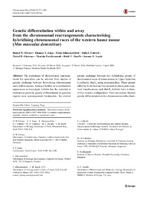Genetic differentiation within and away from the chromosomal rearrangements characterising hybridising chromosomal races of the western house mouse (Mus musculus domesticus)
Date
2016-04-05Author
Förster, Daniel W.
Jones, Eleanor P.
Jóhannesdóttir, Fríða
Gabriel, Sofia I.
Giménez, Mabel Dionisia
Panithanarak, Thadsin
Hauffe, Heidi Christine
Searle, Jeremy B.
Metadata
Show full item recordAbstract
The importance of chromosomal rearrangements for speciation can be inferred from studies of genetic exchange between hybridising chromosomal races within species. Reduced fertility or recombination suppression in karyotypic hybrids has the potential to maintain or promote genetic differentiation in genomic regions near rearrangement breakpoints. We studied genetic exchange between two hybridising groups of chromosomal races of house mouse in Upper Valtellina (Lombardy, Italy), using microsatellites. These groups differ by Robertsonian fusions and/or whole-arm reciprocal translocations such that F1 hybrids have a chain-of-five meiotic configuration. Previous studies showed genetic differentiation in two chromosomes in the chain-of-five (10 and 12) close to their centromeres (i.e. the rearrangement breakpoints); we have shown here that the centromeric regions of the other two chromosomes in the chain (2 and 8) are similarly differentiated. The internal chromosomes of the chain (8 and 12) show the greatest differentiation, which may reflect pairing and recombination properties of internal and external elements in a meiotic chain. Importantly, we found that centromeric regions of some non-rearranged chromosomes also showed genetic differentiation between the hybridising groups, indicating a complex interplay between chromosomal rearrangements and other parts of the genome in maintaining or promoting differentiation and potentially driving speciation between chromosomal races.
Collections
The following license files are associated with this item:




